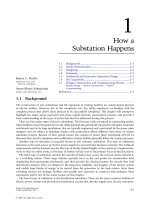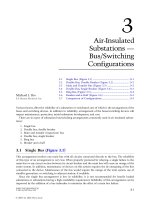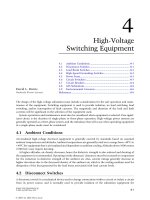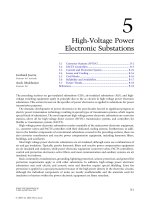electric power substations engineering (3)
Bạn đang xem bản rút gọn của tài liệu. Xem và tải ngay bản đầy đủ của tài liệu tại đây (198.69 KB, 5 trang )
1
-1
0-8493-1703-7/03/$0.00+$1.50
© 2003 by CRC Press LLC
1
How a
Substation Happens
1.1 Background
1
-1
1.2 Needs Determination
1
-2
1.3 Budgeting
1
-2
1.4 Financing
1
-2
1.5 Traditional and Innovative Substation Design
1
-2
1.6 Site Acquisition
1
-3
1.7 Design, Construction, and Commissioning Process
1
-3
Station Design • Station Construction • Station
Commissioning
References
1
-5
1.1 Background
The construction of new substations and the expansion of existing facilities are commonplace projects
in electric utilities. However, due to the complexity, very few utility employees are familiar with the
complete process that allows these projects to be successfully completed. This chapter will attempt to
highlight the major issues associated with these capital-intensive construction projects, and provide a
basic understanding of the types of issues that must be addressed during this process.
There are four major types of electric substations. The first type is the switchyard at a generating station.
These facilities connect the generators to the utility grid and also provide off-site power to the plant. Generator
switchyards tend to be large installations that are typically engineered and constructed by the power plant
designers and are subject to planning, finance, and construction efforts different from those of routine
substation projects. Because of their special nature, the creation of power plant switchyards will not be
discussed here, but the expansion and modification of these facilities generally follow the routine processes.
Another type of substation is typically known as the customer substation. This type of substation
functions as the main source of electric power supply for one particular business customer. The technical
requirements and the business case for this type of facility depend highly on the customer’s requirements,
more so than on utility needs, so this type of station will also not be the primary focus of this discussion.
The third type of substation involves the transfer of bulk power across the network and is referred to
as a switching station. These large stations typically serve as the end points for transmission lines
originating from generating switchyards, and they provide the electrical power for circuits that feed
distribution stations. They are integral to the long-term reliability and integrity of the electric system
and enable large blocks of energy to be moved from the generators to the load centers. Since these
switching stations are strategic facilities and usually very expensive to construct and maintain, these
substations will be one of the major focuses of this chapter.
The fourth type of substation is the distribution substation. These are the most common facilities in
electric power systems and provide the distribution circuits that directly supply most electric customers.
James C. Burke
Baltimore Gas and
Electric Company
Anne-Marie Sahazizian
Hydro One Networks Inc.
1703_Frame_C01.fm Page 1 Monday, May 12, 2003 5:57 PM
© 2003 by CRC Press LLC
1
-2
Electric Power Substations Engineering
They are typically located close to the load centers, meaning that they are usually located in or near the
neighborhoods that they supply, and are the stations most likely to be encountered by the customers.
Since the construction of distribution stations creates the majority of projects in utility substation
construction budgets, these facilities will be the other major focus of this chapter.
1.2 Needs Determination
An active planning process is necessary to develop the business case for creating a substation or making
major modifications. Planners, operating and maintenance personnel, asset managers, and design engi-
neers are among the various employees typically involved in considering such issues in substation design
as load growth, system stability, system reliability, and system capacity, and their evaluations determine
the need for new or improved substation facilities. Customer requirements, such as a new factory, etc.,
should be considered as well as customer relations and complaints. In some instances, political factors
also influence this process, such as when reliability is a major issue. At this stage, the elements of the
surrounding area are defined and assessed, and a required in-service date is established. The planning
process produces a basic outline of what is required in what area.
1.3 Budgeting
Having established the broad requirements for the new station — such as voltages, capacity, number of
feeders, etc. — the issue of funding must be addressed. This is typically when real estate investigations
of available sites begin, since site size and location can significantly affect the cost of the facility. Prelim-
inary equipment layouts and engineering evaluations are also undertaken at this stage in order to develop
ballpark costs, which then have to be evaluated in the corporate budgetary justification system. Prelim-
inary manpower forecasts for all disciplines involved in the engineering and construction of the substation
should be undertaken, including identification of the nature and extent of any work that the utility may
need to contract out. This budgeting process will involve evaluation of the project in light of corporate
priorities and provide a general overview of cost and other resource requirements. Note that this process
may be an annual occurrence. Any projects in which monies have yet to be spent are generally reevaluated
during every budget cycle.
1.4 Financing
Once the time has arrived for work to proceed on the project, the process of obtaining funding for the
project must be started. Preliminary detailed designs are required in order to develop firm pricing.
Coordination between business units is necessary to develop accurate costs and to develop a realistic
schedule. This may involve detailed manpower forecasting in many areas. The resource information has
to be compiled in the format necessary to be submitted to the corporate capital estimate system, and
internal presentations must be conducted to sell the project to all levels of management.
Sometimes it may be necessary to obtain funding to develop the capital estimate. This may be the case
when the cost to develop the preliminary designs is beyond normal departmental budgets, or if unfamiliar
technology is expected to be implemented. This can also occur on large, complex projects or when a
major portion of the work will be contracted. It may also be necessary to obtain early partial funding
in cases where expensive, long-lead-time equipment may need to be purchased, such as large power
transformers.
1.5 Traditional and Innovative Substation Design
Traditionally, high-voltage substations are engineered based on established layouts and concepts and
conservative requirements. This approach can restrict the degree of freedom in introducing new solutions.
1703_Frame_C01.fm Page 2 Monday, May 12, 2003 5:57 PM
© 2003 by CRC Press LLC
How a Substation Happens
1
-3
The most that can be achieved with this approach is the incorporation of new primary and secondary
technology in preengineered standards.
A more innovative approach is one that takes into account functional requirements such as system
and customer requirements and develops alternative design solutions [1]. System requirements include
elements of rated voltage, rated frequency, system configuration present and future, connected loads,
lines, generation, voltage tolerances (over and under), thermal limits, short-circuit levels, frequency
tolerance (over and under), stability limits, critical fault clearing time, system expansion, and intercon-
nection. Customer requirements include environmental consideration (climatic, noise, aesthetic, spills,
right-of-way), space consideration, power quality, reliability, availability, national and international appli-
cable standards, network security, expandability, and maintainability.
Carefully selected design criteria could be developed to reflect the company philosophy. This would
enable consideration and incorporation of elements such as life-cycle cost, environmental impact, initial
capital investment, etc. into the design process. Design solutions could then be evaluated based on
established evaluation criteria that satisfy the company interests and policies.
1.6 Site Acquisition
At this stage, a footprint of the station has been developed, including the layout of the major equipment.
A decision on the final location of the facility can now be made, and various options can be evaluated.
Final grades, roadways, storm-water retention, and environmental issues are addressed at this stage, and
required permits are identified and obtained. Community and political acceptance must be achieved,
and details of station design are negotiated in order to achieve consensus. Depending on local zoning
ordinances, it may be prudent to make settlement on the property contingent upon successfully obtaining
zoning approval, since the site is of little value to the utility without such approval. It is not unusual for
engineering, real estate, public affairs, legal, planning, operations, and customer service personnel —
along with various levels of management — to be involved in the decisions during this phase.
The first round of permit applications can now begin. While the zoning application is usually a local
government issue, permits for grading, storm water management, roadway access, and other environ-
mental or safety concerns are typically handled at the state or provincial level, and they may be federal
issues in the case of wetlands or other sensitive areas. Other federal permits may also be necessary, such
as those for aircraft warning lights for any tall towers or masts in the station. Permit applications are
subject to unlimited bureaucratic manipulation and typically require multiple submissions and could
take many months to reach conclusion. Depending on the local ordinances, zoning approval may be
automatic or may require hearings that could stretch across many months. Zoning applications with
significant opposition could take years to resolve.
1.7 Design, Construction, and Commissioning Process
Once the site location has been selected, the design, construction, and commissioning process would
broadly follow the steps shown in Figure 1.1 [2]. Recent trends in utilities have been toward sourcing
design and construction of substations through a competitive bidding process to ensure capital efficiency
and labor productivity.
1.7.1 Station Design
Now the final detailed designs can be developed along with all the drawings necessary for construction.
The electrical equipment and all the other materials can now be ordered and detailed schedules for all
disciplines negotiated. Final manpower forecasts must be developed and coordinated with other business
units. It is imperative that all stakeholders be aware of the design details and understand what needs to
be built and when it needs to be completed to meet the in-service date. Once the designs are completed
and the drawings published, the remaining permits can be obtained.
1703_Frame_C01.fm Page 3 Monday, May 12, 2003 5:57 PM
© 2003 by CRC Press LLC
1
-4
Electric Power Substations Engineering
FIGURE 1.1
Flow chart illustrating steps involved in establishing a new substation [3].
LOAD GROWTH
ASSESSMENT
TECHNICAL,
ENVIRONMENTAL AND
COMMERCIAL POLICY
END
END
GENERAL PLAN
OF THE NETWORK
IS
REINFORCEMENT
REQUIRED?
IS A NEW
SUBSTATION
REQUIRED?
GENERAL
DESIGN
SPECIFIC
DESIGN
PREPARE
MAIN
CONNECTIONS
AND
PROTECTION
DIAGRAM
PREPARE
CIRCUIT
DIAGRAMS
AND SOFTWARE
PREPARE
WIRING
DIAGRAMS
AND CABLE
SCHEDULE
CIVIL
WORKS
CARRY OUT
CIVIL DESIGN
WORK
DETERMINE
SUBSTATION
LAYOUT
DETERMINE
SITE
LOCATION
PREPARE
PRELIMINARY
PLANS *
* GENERAL LOCATION
,
LINE DIRECTIONS,
SOIL INVESTIGATIONS,
TRANSPORT ROUTES.
CONSIDER
OTHER MEANS
OF
REINFORCEMENT
DETERMINE
EXACT SITE
LOCATION
AND ORIENTATION
INSTALL
PLANT AND
EQUIPMENT
TEST,
COMMISSION,
TAKEOVER
NO
NO
YES
YES
1703_Frame_C01.fm Page 4 Monday, May 12, 2003 5:57 PM
© 2003 by CRC Press LLC
How a Substation Happens
1
-5
1.7.2 Station Construction
With permits in hand and drawings published, the construction of the station can begin. Site logistics
and housekeeping can have a significant impact on the acceptance of the facility. Parking for construction
personnel, traffic routing, truck activity, trailers, fencing, lack of mud and dirt control, along with trash
and noise can be major irritations for neighbors, so attention to these details is essential for achieving
community acceptance. All the civil, electrical, and electronic systems are installed at this time. Proper
attention should also be paid to site security during the construction phase, not only to safeguard the
material and equipment, but also to protect the public.
1.7.3 Station Commissioning
Once construction is complete, testing of various systems can commence and all punch-list items can
be addressed. Environmental cleanup must be undertaken before final landscaping can be installed. Note
that, depending upon the species of plants involved, it may be prudent to delay final landscaping until
a more favorable season in order to insure optimal survival of the foliage. Public relations personnel can
make the residents and community leaders aware that the project is complete, and the station can be
made functional and turned over to the operating staff.
References
1. Carvalho, A. et al., Functional Substation as Key Element for Optimal Substation Concept in a
Deregulated Market, paper presented at CIGRE SC 23 Colloquium, Zurich, 1999.
2. Sahazizian, A.M., The Substation Design Process — An Overview, paper presented at CIGRE SC
23 Colloquium, Venezuela, 2001.
3. CIGRE (Conseil International des Grands Reseaux Electriques) Brochure Nr. 161,
General Guide-
lines for the Design of Outdoor AC Substations,
August 2000, WG 23-03.
1703_Frame_C01.fm Page 5 Monday, May 12, 2003 5:57 PM
© 2003 by CRC Press LLC









